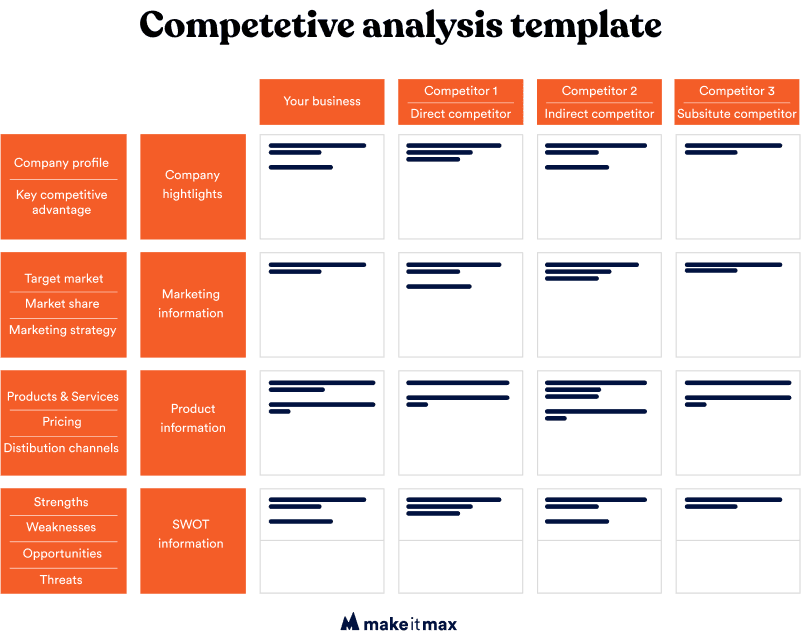What is a competitor analysis in UX design?
For us UX designers, a competitor analysis is a very important item of the many UX research methods where we search for competitors in the industry and compare them to each other and to your company. This way we’ll find out their weaknesses and strengths, their products, market trends and tactics, understand your market and competitors, and we can plan benchmarks to help you grow even more.
Within the whole UX design process, you can focus your competitor analysis on a specific aspect of your business, or go all out and consider all other parts as well. It’s just a matter of tailoring the questions to fit your needs.
When and why do we use a competitor analysis in UX design?
A competitor analysis within the UX design process can really help your business. It is always a good idea to conduct multiple analyses throughout the development and growth of your company. If it’s when you’re just starting out, or you’re already a few years in; it’s always valuable to know what the ‘others’ are doing. Your competitors also grow, have different strategies, and think of the things you wouldn’t have. And wouldn’t you like to know what these are? 😉
With a well-executed competitor analysis, you can make sure your unique selling point or value proposition is truly something your competitors don’t have, and you can plan future marketing strategies and sales efforts on that proposition.
How to make a competitor analysis in UX design?
Before you start your competitor analysis in your UX design process, you have to make a list of all the potential competitors that are in your branch or have a similar target audience. These are usually the companies that first come to mind when thinking about competitors that do the same as you.
Make a list
Direct and indirect competitors
There are direct and indirect competitors; direct competitors have a similar product or service. Indirect competitors sell their products or services to a target audience that has a lot of similarities with yours or have a product that falls in the same category as yours.
For example; Adidas sells sports attire like shoes and clothes. Their direct competitors are Nike and Puma. Their indirect competitors are Fila, Vans, Kappa and Jordan. The reason their direct competitors are Nike and Puma is because they sell approximately the same variety of products to the same target audience. Fila, Vans, Kappa and Jordan are indirect competitors because they don’t have the same variety but do target the same audience or, where they do have the same products, they sell to a slightly different audience.
Replacement competitors
Then there are the replacement competitors where customers would go if the direct and indirect competitors are not available or for some reason aren’t an option. In the previous example, a secondary brand like Bristol or H&M could be a replacement competitor.
Create a graph or grid
Before you dive into comparisons, it’s useful to make a graph of some sort to have all your information in one place and make it easy to compare the different findings.
Here you have to dive a bit deeper into your competitors’ businesses.
The following questions are what you need to think about when setting up your investigation. These questions are also common in other elements of the UX design process, they’re not solely a part of the competitors’ analysis. So chances are, if you have done some research for other parts for your UX design process, these questions are easy to answer.
- What kind of product or service do they sell?
- What features does this product or service have?
- If it’s a product, what kind of service do they provide?
- What kind of prices do they charge?
- What kind of marketing strategies do they use?
- Do they sell online and/or in physical shops?
- What is their target audience?
(This one is very important! Is their target audience the same as yours, or are there differences? This also tells a lot about their communication methods.) - Which pain points do they resolve for their target audience?
- Which channels do they use?
- What is the company profile?
Competitor analysis UX design template

Put these questions into a grid with on the horizontal axes the competitors and on the vertical axes the questions or points you want answered or information about.
Get searching
Now you can scour the internet to find all the available information you can gather about your competitors. Look on their website, browse for blogs they have written or maybe blogs others have written about them, check their social media channels, read about the companies histories, etc.
Don’t only use the information that is available, but also put your head to work and write down things you know about them;
- How do they talk to their target audience on social media?
- What kind of words do they use?
- Which psychological elements do they use to sell their brand?
- Do they play into certain pain points or emotions?
- What is the meaning of the colors they use in their branding?
Analyze
The next step of your competitor analysis in UX design is to put all your information together and search for differences and similarities. Write down what your competitor’s weaknesses and strengths are and, don’t forget, also write down your own. Are there any elements you can use to make your product better? Are there any pain points that you should take notice of and improve? What about methods or strategies that your competitors use that you can learn from?
Make a clear list of your conclusions, and your competitor analysis in UX design is almost ready! Now you have a perfect overview of what is great (and not so great) about your competitors businesses and how you can set yourself apart. I guarantee you that this whole endeavor won’t be for nothing, there is always a piece of information that is useful to help your business get better.
The takeaway
A competitor analysis in UX design may sound like a lot of work, but it doesn’t have to be. If you have a clear idea of what kind of information you need, the searching gets a lot easier. You can make it as big or small as you want, as long as you conduct a thorough analysis.
With your findings you have a clear mapped out idea of your competitors that will help you define a unique proposition. You know exactly the difference between you and your competitors and what makes them and you unique.
Need help?
If you really don’t know where to start your competitor analysis in UX design, we’re here to help you! Just send us a message, and we’ll have you under one of our palm trees in a matter of minutes! With a nice cup of coffee (or cocktail) of course!






0 Comments